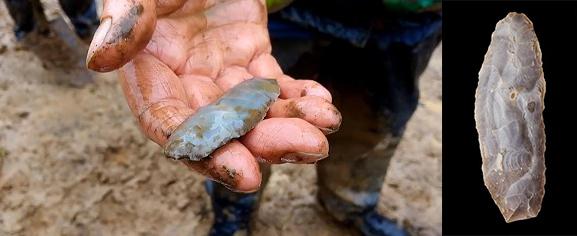Recent archaeological discoveries along the N16 Lugatober Road Development
by Ger Dowling (Senior Archaeologist, Archaeological Management Solutions Ltd) and Orlaith Egan (TII Archaeologist)
Archaeologists working in advance of the proposed upgrade of the N16 Lugatober (Lugnagall to Drumkilsellagh) Road Development, north-east of Sligo town, have recently unearthed a fascinating range of prehistoric sites, as well as more recent sites of cultural heritage interest. The investigations involved nine hectares of geophysical survey and over 11 km of archaeological test trenching, which assisted archaeologists in locating new sites that lay hidden beneath the ground over several millennia. Survey works also included archaeological wade and metal detection surveys of watercourses, and built heritage surveys. The investigation and excavation works were conducted between June and December 2020 by Archaeological Management Solutions (AMS) Ltd on behalf of Sligo County Council and involved up to 30 archaeologists working on 15 different sites.
One of the most thrilling discoveries was a large, palisaded (timber fenced) enclosure, prominently located on a rise at the western foot of Cope’s Mountain in the townland of Castlegal. The enclosure may date from the Bronze Age or Iron Age (between 4,500 and 1,500 years ago) and could have been used for religious or ritual ceremonies and other important communal activities. Three prehistoric burial monuments known as ring-ditches were also excavated nearby in the townlands of Castlegal and Lugatober, and reflect a landscape where the dead were buried and revered in prehistoric times. Perhaps the people who built the Castlegal palisade enclosure buried their dead in these funerary monuments—a question that can be only be explored when further scientific analysis has been completed. Other important finds included a possible prehistoric building—thought to be Sligo’s first Neolithic house—and charcoal-production pits, as well as spreads of charcoal and burnt stone that may be the remains of ancient cooking places.

Aerial view of prehistoric palisade enclosure in Castlegal, Co. Sligo (AMS Ltd).
Some of the excavations uncovered a range of artefacts, including flint tools (blades and scrapers), fragments of pottery and blue glass beads. These objects provide evidence of expert craftsmanship, trade networks, and personal adornment. Other material, such as animal bones, as well as cereal grains and charcoal recovered from soil samples, provide evidence of farming techniques, food consumption, and the local environment.

Flint blade unearthed from a prehistoric timber building in Lugatober, Co. Sligo (AMS Ltd).
Post-excavation works are now well underway since the conclusion of the investigations at the end of 2020. The results of the post-excavation analysis of the archaeological materials and finds retrieved during the excavations will no doubt provide new and exciting insights that will help archaeologists interpret these fascinating sites.
A series of short documentaries about these archaeological discoveries is being produced by AMS, the first two of which can be viewed below. Additional videos will be available on the AMS YouTube channel.
For further information, contact TII Archaeologist Orlaith Egan (Orlaith.Egan@tii.ie).
(Posted 16 June 2021)